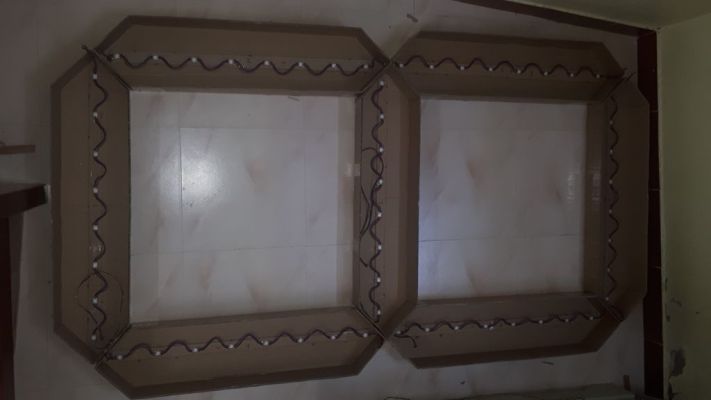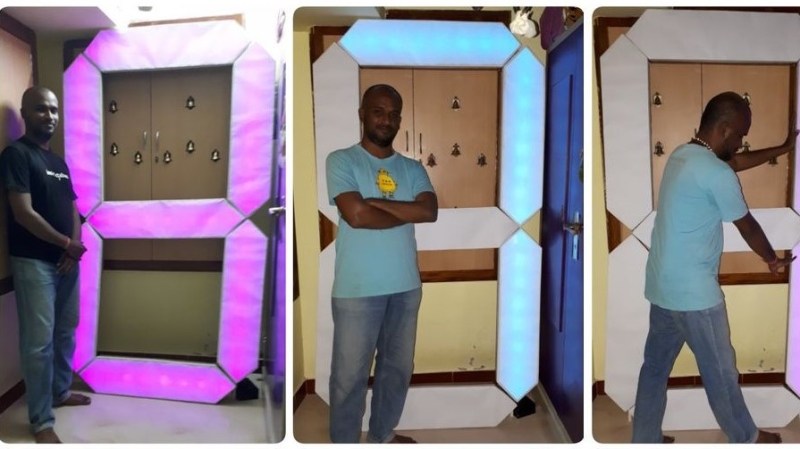The 7-segment display certainly is a popular build, and surprisingly people still come up with new takes on this over a hundred-year-old way to represent numbers. This time [jegatheesan.soundarapandian] is making it big by building a giant 7 feet tall 7-segment display.
 Apparently, the plan is to build a giant clock so he started off by making the first digit. To keep it cheap and simple the segments are made from corrugated cardboard which was carefully cut, folded, and then glued together. The light-diffusing lid is simply made from white paper. He used the ubiquitous WS2812B strips to light up the segments, but things turned out to be more complicated as he was not able to get enough strips to fill up all the segments. This forced him to cut up the strip into individual pieces and space them out by reconnecting the LEDs with wires. Cutting, stripping, and soldering 186 wires took him almost 10 hours. An Arduino Uno serves as the brains of the device and there is a nice Android app to control it via Bluetooth.
Apparently, the plan is to build a giant clock so he started off by making the first digit. To keep it cheap and simple the segments are made from corrugated cardboard which was carefully cut, folded, and then glued together. The light-diffusing lid is simply made from white paper. He used the ubiquitous WS2812B strips to light up the segments, but things turned out to be more complicated as he was not able to get enough strips to fill up all the segments. This forced him to cut up the strip into individual pieces and space them out by reconnecting the LEDs with wires. Cutting, stripping, and soldering 186 wires took him almost 10 hours. An Arduino Uno serves as the brains of the device and there is a nice Android app to control it via Bluetooth.
We are excited to see the complete clock once it is finished. In the meantime let us remember other epic displays like that made from 144 individual 7-segment displays or the giant LED video wall using 1200 ping pong balls.
Video after the break.
















For anyone interested, you can buy ws2812 leds chained together with short lengths of wire from the regular chinese places for not to much.
The search term for this is ws2812 or ws2811 or sk6812 “string”
That’s cool, the final product will be wild. Where would something this huge even be displayed? I have some 12 inch 7-segment display modules from a scoreboard my college was replacing, and they’re too huge for me!
My dad did the same thing more than 30 years ago, except lit by fluorescent tubes. It was a job for the local football club, to display the score, so he did 4 of those plus a box of discrete component and buttons to increase and reset the score.
Fluorescent tubes-thats amazing.
If you throw in some dodgy starters, you can hear the score updating!
I love dodgy starters. I have an ancient 1950s fluorescent fixture in my garage I’m never gonna replace cause it’s always a fun light show when you turn it on.
Isn’t the ws2812 a bit of an overkill for this? It seems that he lights up all the leds in one segment simultaneously. Simple RGB led strips are available in various lengths and densities (LEDs / meter), the downside being that you have to control all channels manually, which may quickly eat up your PWM resources.
If you want to control them using a serial protocol, you can connect a single WS2801 (or similar) with a bunch of transistors per segment.
I’ve also made large format 7 segments using ws2812.
For one-off things is just sooo much easier and quicker dealing with just power, ground and data hooked up to a bluepill or similar rather than spinning a PCB and routing tens of wires and stuff. Especially when you already had some ws2812 strips.
You can also get strips of plain old white LED’s wired for constant voltage power from the usual suspects. You would need power drivers for them but still a lot cheaper and simpler I’d think than enough individually addressable 3-color LED’s to illuminate 20+ feet of display.
WS2812s are around $0.06 each and about $0.15 each as part of a strip.
For that small price, you get a huge decrease in the amount of hassle for projects like this; all you need is a good 5V supply and a microcontroller.
If you want to do this with direct PWM, you are talking about separate mosfets per channel and enough PWM channels to support to do what you want. And you are talking a lot more cabling between the LEDs and the microcontroller instead of just a single data wire.
As interesting as this project is, my eye was drawn to the cupboard in the background. It appears to be a series of bell shaped holes containing bells. As I’ve not seen anything like that before, I’m hoping someone can elucidate on it’s form & function
Mario – it is cabinet which holds prayer items – a small home temple – this kind of design is common in India
https://www.youtube.com/watch?v=iwxQRPPlPVw
https://www.youtube.com/watch?v=uvw0r4T5PuQ